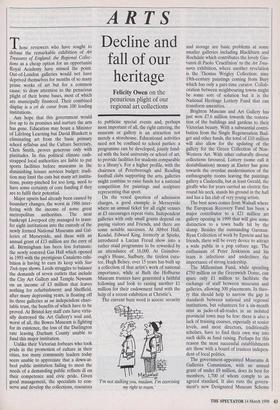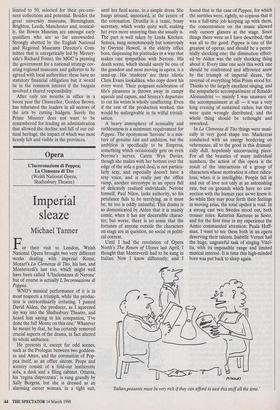ARTS
Decline and fall of our heritage
Felicity Owen on the penurious plight of our regional art collections Those reviewers who have sought to debase the remarkable exhibition of Art Treasures of England: the Regional Collec- tions as a cheap option for an opportunist Royal Academy have missed the point. Out-of-London galleries would not have deprived themselves for months of so many prime works of art but for a common cause: to draw attention to the penurious plight of their home bases, most of which are municipally financed. Their combined display is a cri de coeur from 100 leading institutions.
Any hope that this government would live up to its promises and nurture the arts has gone. Education may boast a Minister of Lifelong Learning but David Blunkett is eliminating art from the basic primary school syllabus and the Culture Secretary, Chris Smith, proves generous only with platitudes. In this political climate cash- strapped local authorities are liable to put sports facilities before museums in the diminishing leisure services budget: tradi- tion may limit the cuts but many art institu- tions, penny-pinched for too long, need to have some certainty of core funding if they are to fulfil their potential. Major upsets had already been caused by boundary changes, the worst in 1986 inter- fering with the income of some great metropolitan authorities. The near bankrupt Liverpool city managed to trans- fer eight institutions into the custody of the newly formed National Museums and Gal- leries of Merseyside, and these with an annual grant of £13 million are the envy of all. Birmingham has been less fortunate: the newly restored Gas Hall which opened in 1993 with the prestigious Canaletto exhi- bition is having to earn its keep with Star Trek-type shows. Leeds struggles to balance the demands of seven outlets that include the City Art Gallery and Temple Newsam on an income of £3 million that leaves nothing for refurbishment; and Sheffield, after many depressing years, is floating off its three galleries as an independent chari- table trust, the benefits of which have to be proved. At Bristol key staff cuts have virtu- ally destroyed the Art Gallery's soul and, worst of all, the Bowes Museum is fighting for its existence, the loss of the Darlington rate leaving Durham County unable to fund this major institution.
Unlike their Victorian forbears who took pride in the promotion of culture in their cities, too many community leaders today seem unable to appreciate that a down-at- heel public institution failing to meet the needs of a demanding public reflects ill on their competence and civic pride. Given good management, the specialists to con- serve and develop the collections, resources to publicise special events and, perhaps most important of all, the right catering, the museum or gallery is an attraction not merely a storehouse. Educational activities need not be confined to school parties: a programme can be developed, jointly fund- ed with the local university or school of art, to provide facilities for students comparable to a library's. For a higher profile, with the chairmen of Peterborough and Reading football clubs supporting the arts, galleries might combine to raise funds for a national competition for paintings and sculpture representing that sport.
On the vexed question of admission charges, a good example is Merseyside where an annual ticket for all eight venues at £3 encourages repeat visits. Independent galleries with only small grants depend on paying visitors and Friends, and there are some notable successes. At Abbot Hall, Kendal, Edward King, formerly at Spinks, introduced a Lucian Freud show into a rather staid programme to be rewarded by an attendance of 16,000. At Gainsbor- ough's House, Sudbury, the tireless cura- tor, Hugh Belsey, over 15 years has built up a collection of that artist's work of national importance, while at Bath the Holburne Museum trustees have generated a faithful following and look to raising another £1 million for their endowment fund with the help of a recent exhibition at Christie's.
The current buzz word is access: security 'I'm not stalking you, madam. I'm exercising my right to roam.' and storage are basic problems at some smaller galleries including Blackburn and Rochdale which contributes the lovely Gio- vanni di Paolo 'Crucifixion' to the Art Trea- sures exhibition, where another revelation is the Thomas Wrigley Collection: nine 19th-century paintings coming from Bury which has only a part-time curator. Collab- oration between neighbouring towns might be some sort of solution but it is the National Heritage Lottery Fund that can transform amenities.
Brighton Museum and Art Gallery has just won £7.6 million towards the restora- tion of the buildings and gardens to their Victorian beauty. With a substantial contri- bution from the Single Regeneration Bud- get and other funds, the total of £10 million will also allow for the updating of the gallery for the Green Collection of Non- Western Art. With other culturally diverse collections favoured, Lottery (some call it destabilisation) money at Exeter has gone towards the overdue modernisation of the enthnography rooms leaving the paintings gallery a Cinderella, but at least Gerald, the giraffe who for years carried an electric fire round his neck, stands his ground in the hall and has a fan club of very young artists.
The best news comes from Walsall where the European Recovery Fund has been a major contributor to a £21 million art gallery opening in 1999 that will give some distinction to a town badly hit by the slump. Besides the outstanding Garman- Ryan Collection of work by Epstein and his friends, there will be every device to attract a wide public in a pop culture age. The enthusiasm of Peter Jenkinson and his team is infectious and underlines the importance of strong leadership.
The Millennium Fund, while spending £750 million on the Greenwich Dome, can spare only £1 million to facilitate the exchange of staff between museums and galleries, allowing 300 placements. In theo- ry this should help to narrow the gap in standards between national and regional institutions, but volunteers for a six-month stint as jacks-of-all-trades in an isolated provincial town may be few: there is also a lack of training courses, especially at senior levels, and most directors, traditionally scholars, have to find their own way into such skills as fund raising. Perhaps for this reason the most successful establishments are those with a board of trustees indepen- dent of local politics.
The government-appointed Museums & Galleries Commission, with an annual grant of under £9 million, does its best for members, 1,700 of whom comply to an agreed standard. It also runs the govern- ment's new Designated Museum Scheme limited to 50, selected for their pre-emi- nent collections and potential. Besides the great university museums, Birmingham, Brighton, Leeds, Manchester and, ironical- ly, the Bowes Museum are amongst early qualifiers who are so far unrewarded, Strongly abetted by the English National and Regional Museums Director's Com- mittee that is energetically led by Mersey- side's Richard Foster, the MGC is pressing the government for a national strategy cov- ering regional museums and galleries to be agreed with local authorities: these have no statutory financial obligation but it would be in the common interest if the bargain involved a shared responsibility.
After only ten months in office in a boom year the Chancellor, Gordon Brown, has infuriated the leaders in all sectors of the arts by cutting budgets. Surely the Prime Minister does not want to be remembered for leading an administration that allowed the decline and fall of our cul- tural heritage, the impact of which was most keenly felt and visible in the provinces.



































































 Previous page
Previous page